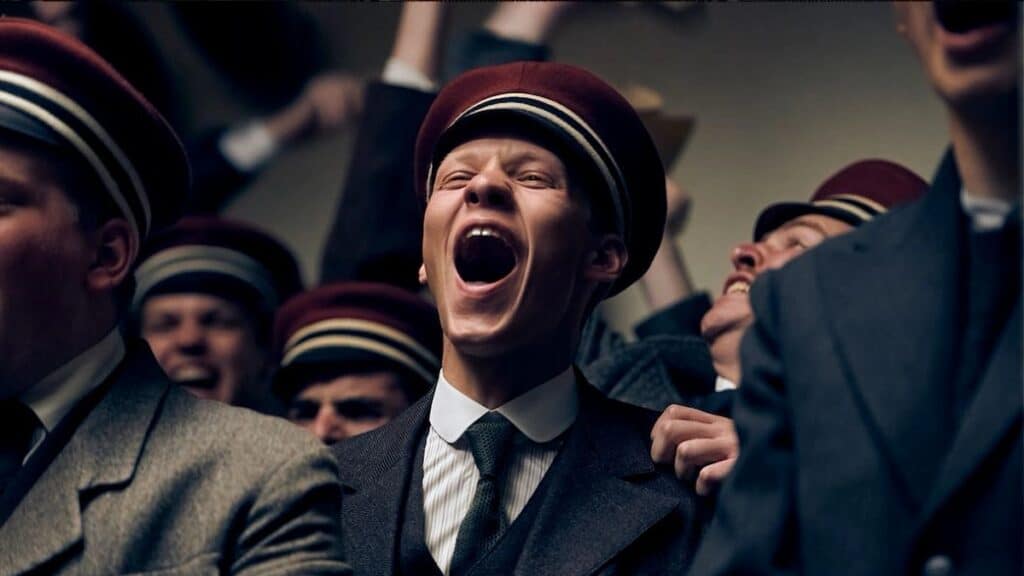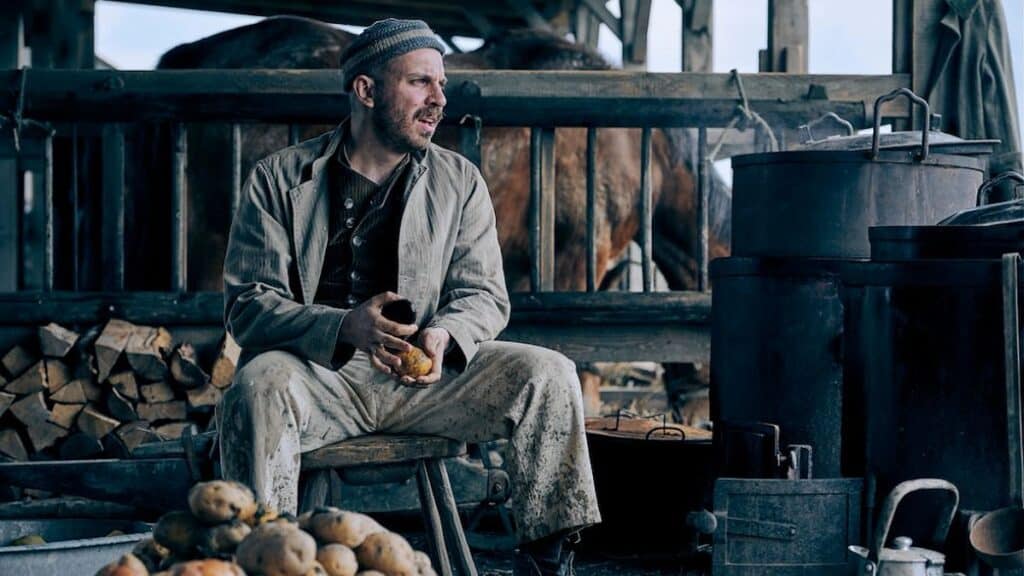Germany’s Oscar submission is still a grueling wonder even if it doesn’t adapt the source material’s stirring introspection.
“Peace” and “quiet” are not the same, and it’s one of the many lessons awaiting those who will come and see Edward Berger’s latest feature. Interestingly, however, it isn’t the most apparent of lessons to pick out at the end of this adaptation of Erich Maria Remarque’s All Quiet on the Western Front.
The film presents vistas so still they resemble paintings, trees so undisturbed they might be statues. Only in extreme close-ups can you hear the fox cubs rustling. These are representations of “peace.” As for those of “quiet,” look at the immobile bodies—muddied, bloodied, or quicklimed. Witness the cutaway after an entrenching shovel’s violent “thwack!”. See the recycled uniforms drying out on clotheslines. Under James Friend’s supervision, all of All Quiet’s images are composed to affect. The best performers bring out the contrast between the tranquility of living things and the silence of the dead.

These extremes are present in All Quiet on the Western Front’s world for one simple reason: 1917. That’s three years into World War I—one year until its end. The old continue to convince the young to take up arms for notions glorious yet invisible, to define peaceful conditions as the outcome of quietened opposition. A statement delivered evocatively and without a hint of irony in the film demonstrates this: “The Kaiser needs soldiers, not children.” If, for any reason, you’ve been uncertain that Berger’s work is “1917from the losers’ perspective,” let those words be the deciding element.
As a believer of the “Iron Youth” package, the older men in charge would eloquently hawk, All Quiet’s school-aged protagonist Paul (Felix Kammerer) sees it ideal to lie about his age and enlist. For “Kaiser, God & the Fatherland,” he will fight, but also the ladies who he thinks can’t resist uniformed heroes. Of course, Paul is far from the only person with this admittedly simple mindset—his friends are Albert (Aaron Hilmer), Tjaden (Edin Hasanovic), Franz (Moritz Klaus), and Ludwig (Adrian Grünewald) joining the fray, too. Still, the script from Berger, Lesley Paterson, and Ian Stokell reserves the most attention for him. Interspersed throughout Paul’s ordeal, one that a combat veteran-slash-father figure Kat (Albrecht Schuch) often co-experiences, are dialogue-heavy efforts toward an armistice with the Allied Powers from Matthias Erzberger (Daniel Brühl).
Under James Friend’s supervision, all of All Quiet’s images are composed to affect.
Unfortunately, All Quiet on the Western Front doesn’t opt for subtler strokes or give them as much attention as the maximal strikes because the more captivating telling resides there. What the characters don’t audibly point out or when the footage chooses to stray from the mainstays of war cinema—these are the better-to-best moments of the tale.
The beautiful visual storytelling unfolds in the background, emphasizing the war’s toll, showcasing the production’s immensity. The “terror of war” is more than not making it home. It’s also being unable to die right when one desires it most or marching on with decreasing humanity. Respite from the elements’ harshness also clarifies the battles’ brutality. There are moments during Peter and company’s desperate escape from flamethrowers and tanks that will encourage viewers to hide their eyes.
Again, these takeaways require viewers look beyond or away from the center of the frame. It’s an approach that can contradict Berger’s uber-upfront vision. Nonetheless, it is necessary to find resonance. If not, there is frankly nothing new in the West, much like the source material’s literal title, Im Westen nichts Neues. One could argue that there’s even less. Telling more than showing defines characters. Events unfold through extension rather than concision.

By looking beyond and away, there are seemingly more refreshing points to latch onto, those free from the overwhelming guidance of Berger and crew and the (fitting) bluntness of Remarque’s anti-war voice. That aforementioned distinction between “peace” and “quiet” is the most crucial one. None of the characters, thankfully, ever say this outright. However, when they encounter the “quiet,” they feel fearful and empty. Recalling bringing death to others, knowing their own time is up. Aware of the inevitable uselessness of the fighter should there be a ceasefire.
The same applies when people know what defines “peace.” Some of the boys get to be juveniles around a pot of goose stew. They muster up what little French they know to woo some girls. The soldiers talk about home. These moments bolster the material’s tragic quality better than the graphic exhibits because they examine the soldiers’ internal experiences. They let the film inhabit the same reflective plane the renowned text once visited, concluding with the same assertion that, at its core, war is an extinguisher of futures. If there were more, Berger’s All Quiet on the Western Front would be excellent. However, in its current form, it’s still a commendable, if over-devoted to forcefulness, exploration of a catastrophe.
All Quiet on the Western Front premieres on Netflix October 28th.
All Quiet on the Western Front trailer:
Read next: The Spool's Best New Releases
Streaming guides
The Best Live TV Streaming Services With Free Trial
The praises of live TV streaming services don’t need to be further sung. By now, we all know that compared to clunky, commitment-heavy cable, live TV is cheaper and much easier to manage. But just in case you’re still on the fence about jumping over to the other side, or if you’re just unhappy with ... The Best Live TV Streaming Services With Free Trial
How to Watch Power Book III: Raising Kanan Season 3
Season 3 of the hotly anticipated Power spin-off, Power Book III: Raising Kanan, is arriving on Starz soon, so you know what that means: it’s the ’90s again in The Southside, and we’re back with the Thomas family as they navigate the ins and outs of the criminal underworld they’re helping build. Mekai Curtis is ... How to Watch Power Book III: Raising Kanan Season 3
How to Watch Doctor Who: 60th Anniversary Specials
Ladies and gentlemen, we’re so back! To celebrate Doctor Who’s 60th anniversary, the BBC is producing a three-episode special starring none other than the Tenth/Fourteenth Doctor himself, David Tennant. And to the supreme delight of fans (that would be me, dear reader), the Doctor will be joined by old-time companion Donna Noble (Catherine Tate) and ... How to Watch Doctor Who: 60th Anniversary Specials
Which Netflix Country has Interstellar?
Maybe you’ve just seen Oppenheimer and have the strongest urge to marathon—or more fun yet, rank!—all of Christopher Nolan’s films. Or maybe you’re one of the few who haven’t seen Interstellar yet. If you are, then you should change that immediately; the dystopian epic is one of Nolan’s best, and with that incredible twist in ... Which Netflix Country has Interstellar?
Which Netflix Country Has Each Movie of The Hunger Games?
For whatever reason, The Hunger Games series isn’t available in the same countries around the world. You’ll find the first and second (aka the best) installments in Hong Kong, for instance, but not the third and fourth. It’s a frustrating dilemma, especially if you don’t even have a single entry in your region, which is ... Which Netflix Country Has Each Movie of The Hunger Games?
How to Watch ESPN With A Free Trial
One of the major concerns people have before cutting the cord is potentially losing access to live sports. But the great thing about live TV streaming services is that you never lose that access. Minus the contracts and complications of cable, these streaming services connect you to a host of live channels, including ESPN. So ... How to Watch ESPN With A Free Trial
How to Watch Paramount Network With a Free Trial
To date, Paramount Network has only two original shows on air right now: Yellowstone and Bar Rescue. The network seems to have its hands full with on-demand streaming service Paramount+, which is constantly stacked with a fresh supply of new shows. But Yellowstone and Bar Rescue are so sturdy and expansive that the network doesn’t ... How to Watch Paramount Network With a Free Trial
How to Watch WE TV With a Free Trial
Previously “Women’s Entertainment,” We TV has since rebranded to accurately reflect its name and be a more inclusive lifestyle channel. It’s home to addictive reality gems like Bold and Bougie, Bridezillas, Marriage Boot Camp, and The Untold Stories of Hip Hop. And when it’s not airing original titles, it has on syndicated shows like 9-1-1, ... How to Watch WE TV With a Free Trial
How to Watch TNT Sports With A Free Trial
For many sports fans, TNT is a non-negotiable. It broadcasts NBA, MLB, NHL, college basketball, and All Elite Wrestling matches. And, as a bonus, it also has reruns of shows like Supernatural, Charmed, and NCIS, as well as films like The Avengers, Dune, and Justice League. But while TNT used to be a cable staple, ... How to Watch TNT Sports With A Free Trial
How to Watch Comedy Central With a Free Trial
It’s no coincidence that many of today’s biggest comedians found their footing on Comedy Central: the channel is a bastion of emerging comic talents. It served as a playground for people like Nathan Fielder (Fielder For You), Ilana Glazer and Abbi Jacobson (Broad City), Tim Robinson (Detroiters), and Dave Chappelle (Chappelle’s Show) before they shot ... How to Watch Comedy Central With a Free Trial
How to Watch FX With a Free Trial
You’d be hard-pressed to find a bad show airing on FX. The channel has made a name for itself as a bastion of high-brow TV, along with HBO and AMC. It’s produced shows like Atlanta, Fargo, The Americans, Archer, and more recently, Shogun. But because it’s owned by Disney, it still airs several blockbusters in ... How to Watch FX With a Free Trial